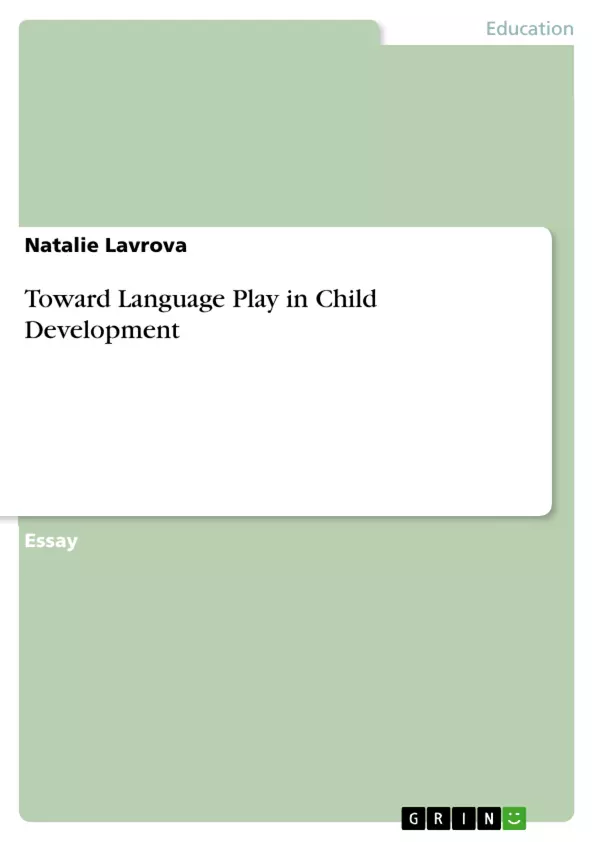The article focuses on some aspects of language play in children and its link to children's intellectual and emotional development. The author strives to demostrate that verbal play is a result of a creativity penchant, which is ultimately conducive to progress and development.
Lavrova N.A.
Toward Language Play in Child Development
Language play takes place when one distorts either the form, the semantics or functions of linguistic units in search of entertainment for oneself or for the recipients. It would not be an exaggeration to say that everyone, regardless of background and educational level, to a certain extent plays with language or responds to language play: “The responses range from the primitive pleasure experienced by severely mentally handicapped children when they hear dramatically contrasting tones of voice… to the cerebral bliss experienced by highly sophisticated connoisseurs as they explore the patterns of sound play in, for example, James Joyce’s Finnegan’s Wake” [Crystal, 1996:328]. One can definitely feel that the second part of the passage by D. Crystal is ironic and probably even sarcastic, for it is hard to enjoy the nonsensical strings of graphemes with which the novel is interspersed. Apparently, the perceptual problem with “Finnegan’s Wake” is not actually that the strings are completely devoid of sense, but that graphemic representation is superfluous in conveying some vague snippet of sense, if, indeed, any. One is also hard put to appreciate the hard-to-perceive, the hard-to-digest wording of the novel, because the plot is not clearly structured, syntactic rules are extensively violated. For some professionals verbal play is part and parcel of almost everyday routine. For journalists, editors and sub-editors the success of what they are going to sell to the public to a great extent depends on how ingenious they are with their captions and headlines. The likelihood that the potential reader will read the whole article increases if the headline is verbally playful, although one should not carry it too far, for it is the tabloids that are prone to sensationalize their articles by inserting all kinds of distortions into the headlines. Copywriters and advertising agencies are another source of copious facetious examples, some of which are deemed as more successful than others.
Frequently asked questions
What is the main topic of "Toward Language Play in Child Development" by Lavrova N.A.?
The text focuses on language play, which is defined as distorting the form, semantics, or functions of linguistic units for entertainment. It explores the prevalence and importance of language play in both adults and child development.
How does the author define language play?
Language play is defined as the distortion of either the form, the semantics, or functions of linguistic units, done in search of entertainment for oneself or for the recipients.
What does the text say about the appeal of language play?
The text suggests that language play appeals to people of all backgrounds and educational levels, from simple pleasure to complex appreciation of patterns. It also touches on the use of language play in professional settings, such as journalism and advertising.
What is the author's opinion on James Joyce’s "Finnegan’s Wake"?
The author expresses a critical view of "Finnegan's Wake," finding the nonsensical graphemes and complex wording hard to perceive and digest, questioning the novel's clarity and structure.
How do journalists and copywriters use language play?
Journalists and copywriters use language play to create engaging headlines and advertisements, aiming to attract readers and consumers. The text notes that excessive sensationalism should be avoided.
What are some observations made about language play in children?
The text refers to K. Chukovsky's observation about children's need for nonsense and topsy-turvy worlds. It also mentions I. Opie and P. Opie's view that rhyme appeals to children without necessarily requiring wit or reason.
What is "solitary behavior" in the context of child development?
Solitary behavior is a form of play, both verbal and non-verbal, where a child engages in a soliloquy, which may be dialogic or polilogic in form, playing all the parts themselves. Other children tend to ignore these vocalizations.
What is a "misnomer" period in child development?
A "misnomer" period is a stage in development starting around age 2.5 where children deliberately reverse names or misapply nominations for fun. This can manifest in mislabeling objects or using greetings inappropriately.
Why do children enjoy verbal play?
Children enjoy verbal play because it involves deviating from the normal use of language forms or using normal forms in unexpected contexts. This may be related to developing a sense of humor or experimenting with causal relationships.
- Citation du texte
- Natalie Lavrova (Auteur), 2010, Toward Language Play in Child Development, Munich, GRIN Verlag, https://www.grin.com/document/151436



